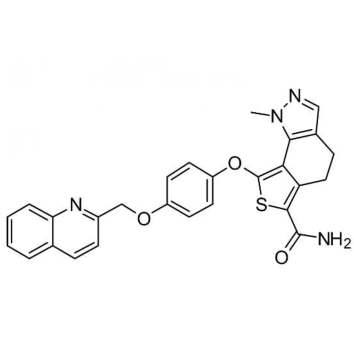| Cas No.: | 364762-86-7 |
| Synonyms: | TD198946,TD 198946 |
| SMILES: | CN1C2=C(CCC3=C(SC(=C32)OC4=CC=C(C=C4)OCC5=NC6=CC=CC=C6C=C5)C(=O)N)C=N1 |
| Formula: | C27H22N4O3S |
| M.Wt: | 482.1 |
| Purity: | >98% |
| Sotrage: | 2 years -20°C Powder, 2 weeks 4°C in DMSO, 6 months -80°C in DMSO |
| Description: | TD-198946, a thienoindazole derivative, is a potent chondrogenic agent. |
| In Vivo: | When administered directly into the joint space, TD-198946 successfully prevents and repaires degeneration of the articular cartilage. TD-198946 exerts its effect through the regulation of Runx1 expression, which is downregulated in both mouse and human OA cartilage compared with normal tissue[1]. TD-198946 has disease-modifying effects on progressed osteoarthritis. TD-198946 may prevent the progression of osteoarthritis by acting on the remaining chondrocytes rather than repairing damaged cartilage, it may be most effective as a therapeutic during the early or middle stages of osteoarthritis, before the articular cartilage is fully eroded[2]. Cartilaginous cell-sheets are generated by culturing mouse and canine costal chondrocytes and human mesenchymal stem cells with TD-198946 on temperature-responsive dishes. The transplanted cell-sheets are then successfully used to promote the reconstruction of permanent cartilage, with no evidence of chondrocyte hypertrophy in the knee articular cartilage defects created in mice and canines[3]. |
| In Vitro: | TD-198946 is a potent chondrogenic agent. TD-198946 strongly induces chondrogenic differentiation without promoting hypertrophy in cell and metatarsal organ cultures. TD-198946 induces stronger Col2a1 promoter activity than insulin in ATDC5 cells. In C3H10T1/2 cells, ATDC5 cells and primary mouse chondrocytes, TD-198946 dose-dependently stimulates endogenous expression of the chondrocyte markers Col2a1 and Acan, with maximum effects around 1-10 μM[1]. |
| Animal Administration: | Mice: Each of the prevention and repair models had two groups: (1) TD-198946-treated animals and (2) saline-treated animals. In all the mice tested the left knee joints underwent the operation and the right knee joints are sham-operated. Mice are re-anaesthetised and given a 10 µL intra-articular injection of TD-198946 or saline immediately after surgery (prevention model) or 4 weeks following surgery (repair model) every 5 days for 8 or 4 weeks, respectively[1]. |
| References: | [1]. Yano F, et al. A novel disease-modifying osteoarthritis drug candidate targeting Runx1. Ann Rheum Dis. 2013 May;72(5):748-53. [2]. Yano F, et al. Disease-modifying effects of TD-198946 on progressed osteoarthritis in a mouse model. Ann Rheum Dis. 2014 Nov;73(11):2062-4. [3]. Yano F, et al. Cell-sheet technology combined with a thienoindazole derivative small compound TD-198946 for cartilage regeneration. Biomaterials. 2013 Jul;34(22):5581-7. |

 To enhance service speed and avoid tariff delays, we've opened a US warehouse. All US orders ship directly from our US facility.
To enhance service speed and avoid tariff delays, we've opened a US warehouse. All US orders ship directly from our US facility.




















